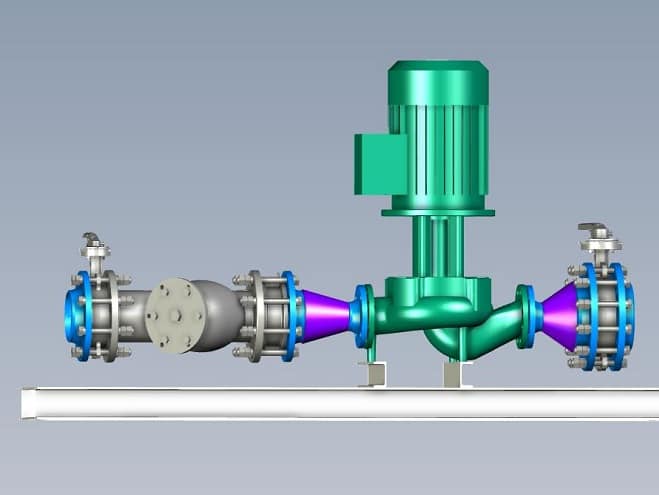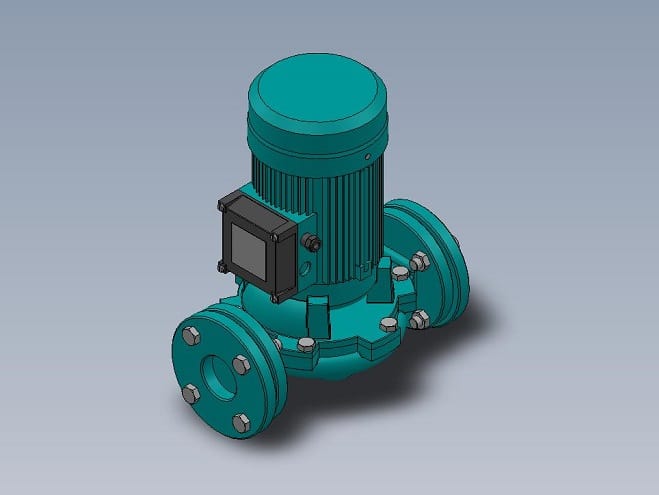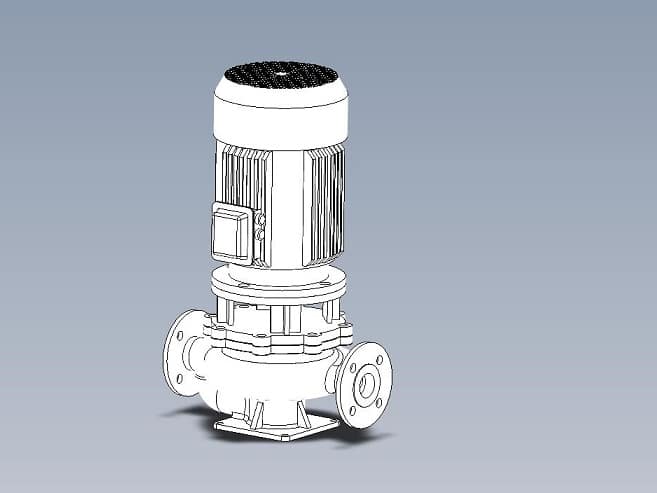Inline Pump
Introduction
An inline pump is a type of centrifugal pump in which the suction and discharge nozzles lie in a straight line of piping or inline with each other within the pump casing. This kind of pump is also referred to as a straight-line pump. The inline pump is powered using an electric motor and uses an impeller and centrifugal force to move liquids from one location to the place where it is required. The pump is characterized by a non-variable fluid flow with the pump
REQUEST A QUOTE FOR MORE DETAILS
What is an inline pump?
The Inline pumps are mostly used in building applications such as air conditioning and water heating and circulation systems. They are also used for pumping water, and as booster pumps in thermal power stations and water supply stations. The design of inline pumps also enables handling of thermal expansion; hence the pumps are highly suitable for the transfer of high temperature and high-pressure products. Due to their inline flow, these pumps may be installed like valves in pipelines. The inline pumps are small with less space requirement compared to other large types of pumps. Most inline pumps, however, lack the self-priming ability and are mostly used for pumping liquids that contain little or no sediments in them.
How does an inline pump work?
The working process of an inline pump follows the following stages
- Firstly, the rotor is mechanically powered through the use of an electric motor or engine. The impeller is directly coupled to the electric motor via a shaft and it rotates at the same RPM as the motor.
- Due to the rotation of the impeller, a vacuum is created inside the impeller’s eye and the liquid is drawn inside the impeller’s eye in the axial direction.
- Once the water strikes the blades of the impeller, the centrifugal force acting on the blades rotates the water radially and axially outwards until it passes through all of the impeller components.
- The impeller blades impart kinetic energy on the fluid and accelerate it toward the pump casing.
- At the inline pump casing, the water is rotated at the same speed as the fluid is gradually decreased leading to the conversion of the kinetic energy of water into pressure head. when the fluid attains the desired pressure, it discharges through the pump outlet and pumps to the required location.
Types of inline pumps
The inline pumps are broadly classified into horizontal and vertical inline pump types. This classification is based on the orientation of the pump’s shaft. They are also classified depending on the number of pump stages as single-stage inline pumps and multi-stage inline pumps. Other types include PTFE lined inline pumps and anti-explosion inline pumps
- vertical inline pump
A vertical inline pump has its pump shaft oriented vertically to the surface of the water source. These pumps are mostly used as circulator pumps in applications where the water flowing through a pipe network needs to be pressurized. In most commercial applications, vertical inline pumps are suspended along with the piping network like valves. Vertical inline pumps are considered better than horizontal inline pumps because they have high efficiency and can tolerate higher temperatures and pressure. Vertical inlet pumps also save more space compared to their horizontal counterparts. However, vertical pumps can only operate with a motor and cannot be directly coupled to an engine or a turbine.
- Horizontal inline pump
In a horizontal inline pump, the pump’s shaft is oriented horizontally to the surface of the water source. Pumps of this kind can be directly coupled to a motor, a turbine, or an engine, which is not the case with vertical inline pumps. A major advantage of the horizontal inline pumps is that the total load due to the pump and motor is spread over a wide area on the bedplate. These pumps are small in size and easy to install. Horizontal inline pumps are suitable for industrial and urban water supply and drainage, transfer of pressurized water in high-rise buildings, booster pumps, long-distance water pumping, HVAC refrigeration cycle, and many more.
- Multistage inline centrifugal pump
This type of inline centrifugal pump has three or more impellers. Ina multi-stage inline centrifugal pump, the water passes through multiple liquid chambers that are connected in series. The number of chambers equals the pump stages and the pressure of the fluid increases with the number of stages. Therefore, water will have low pressure when entering the pump and will have a much higher pressure when leaving the chamber. Multi-stage inline pumps are extensively used in a variety of industrial applications where high-pressure flow is required including pressure boosting systems, pressure jet cleaning, high-pressure wash down, and boiler feed and condensate systems.
- PTFE lined inline pump
PTFE or Teflon lined inline pump is a type of centrifugal pump that combines the mechanical advantages of metallic casings and chemical resistance of the thermoplastic coating. Due to the Teflon coatings, these pumps do not have a wetted surface. TFE lined pump coatings are commonly used for high purity applications, where contact between the product and metallic parts is undesirable. They are also suitable for the transfer of inorganic acids, alkalis, or salts, which normally require that the pump be constructed out of expensive alloys.
- Anti-explosion inline pump
This is a type of inline pump that is explosion-proof. Anti-explosion inlet pumps are designed for applications that may be susceptible to explosions. one such application is in the mining and gas industries, where a lot of pressurized escaping gases are often encountered. To enhance the explosion-proof properties, the Anti-explosion proof inlet pump is installed with a spark-free motor and engineered flame paths. The motor vessel’s structure is also designed to withstand the high pressure that may arise from internal explosions without fracturing. Anti-explosion inline pumps are also suited for landfill leachate application, where decomposing waste produces methane, and chemical plants and refineries, where liquid emits flammable vapors.
Advantages of inline pump
- Space saver
Inline pumps have small space requirements because the suction and discharge nozzles are inline. The pumps are commonly used in buildings where space is limited.
- Inline pumps are highly reliable and efficient
- Low Net Positive Suction Head (NPSH). The inline pump design gas low NPSH, which facilities easier fluid flow through the pump. It also minimizes the suction pressure that is required to feed the pump.
- Inline pumps have an outstanding ability to handle thermal expansion. The inline pumps can withstand heat due to their high thermal expansion. This facilitates their application in handling high-temperature and high-pressure products.
- The pumps are easy to install and maintain
- Their piping design is simple and the pumps can be suspended like valves
- The cost of operation of the inline pump is low
- The pumps can run without seal under low flow conditions
Disadvantages of inline pump
- An inline pump cannot move liquids containing solid particles
- weight of a vertical inlet pump is unequally distributed and mostly concentrated below the pump casing
- The pumps lack the self-priming ability
- Inline pumps have mechanical seal problems. The dissolved or entrained gases in some fluids may infiltrate and accumulate in the seal chamber of an inline pump and cause the mechanical seals to dry out or fail.
- Inline pumps are prone to corrosion due to the accumulation of seal leakage above the pump casing.
Inline pump applications
Inline pumps have a wide range of industrial applications, among them:
- Water heating and circulation systems. This is because the pump cans withstand high temperatures
- Boilers
- cooling towers
- air conditioning system
- Thermal power stations
- water supply systems
- Booster pumps
- Valves in pipelines
Selection of inline pump
The selection of an inline pump for a particular application is based on various performance parameters such as the following.
Type of inline pump
The pump must be selected depending on the arrangement of pump components. The inline pumps are classified according to their shaft orientation as vertical and horizontal inline pumps. Each configuration has advantages and shortcomings, and the best type of pump should be based on the ability of the pump to satisfy the application requirements. For example, a vertical inline pump operates only when directly coupled to a motor and is the best choice of pump for high-temperature and high-pressure applications. Horizontal inline pumps on the other hand offer a wide range of drive options and can be powered using a motor, a turbine, or diesel engine. However, a horizontal inline pump can only work in limited temperature and pressure conditions.
Number of pump stages
Inline pump manufacturers avail both single and multistage inline pumps. Multistage inline pumps are best suited for applications involving high pressure such as booster pumps for pressurizing fluids. on the other hand, a single-stage inline pump mostly applies in the transfer of more direct and low flow fluids.
Power
In industrial pump applications, pump power refers to the amount of energy needed to move liquid from the suction side to the discharge side of the pump. Generally, the inline pump require a sufficient supply of power to manage the required fluid pressure head and flow rate. The supply power should match the rated power on the pump’s nameplate. The amount of power is usually expressed in terms of Horse Power (HP).
Flow rate
The inline pump flow rate is the amount of fluid that is being transferred by the pump per unit of time. It is usually expressed in units of volume per minute or gallon per minute (GPM).
Head
Pump head can be described as the height to which the pump can pressurize the fluid. The maximum heat is the height at which the fluid records zero flow rate. The head is measured in feet. Inline pumps can be able to meet high-pressure head requirements easily.
End flanges
The pump flanges should fit and align perfectly for easier installation and adequate pump performance. There are two standards of sizing flanges: ANSI and API standards.
Inline pump troubleshooting
The inline pump gives zero flow after startup
- Air in the pump or suction pipework (fill the pump or pipework with water, this is to drive out the air from the pump system because the pump cannot prime with air)
- Suction lift is too high (raise liquid in the suction tank or lower the pump to lower the static lift, inspect for inlet obstruction)
- The inline pump operation is reversed (Ensure that the direction of the motor rotation corresponds to the direction of the arrow on the pump casing; if the rotation direction is counter to the direction indicated by the arrow, reverse the pump polarities)
- Impeller, strainer, or check vale clogged (inspect; clean)
- Insufficient monomeric head (This may occur because of higher friction losses compared to the pump design, to correct this, increase the pump power or the diameter of the impeller, and pipes.)
Inlet pump driver overloaded
- Inline pump speed is too high (Decrease the rotational speed of the pump)
- mechanical friction within the pump (inspect the pump assembly for any obstruction or deflection)
- Packing wound too tight (check and loosen nuts on packing glands as necessary)
- Use of too high density or viscosity fluid (confirm that the motor is working with the right type of fluid; if not, increase the motor size)
- Coupling misalignment (Inspect coupling alignment and realign pump and motor)
- The inline pump motor has certain defects (inspect motor defect: poor ventilation, or location; and repair).
Bearing overheating
- Inline pump has poor coupling alignment (check and realign)
- Tightly fixed bearing covers (loosen the bearing covers)
- Excessive grease (drain excess grease)
- Inline pump has insufficient lubrication or lubricating oil contaminated with dirt (inspect the level of oil or grease. clean the bearing casing and lubricate)
Inlet pump experiencing excessive vibration
- Inline pump impeller partially clogged (clean the impeller)
- The impeller is severely worn out (replace impeller)
- Oblique or unbalanced shaft (check shaft and replace or balance as required)
- poor coupling alignment (inspect; align)
Summary
This article discusses the inline pumps under the types of inline pumps, operation principle, applications, selection, troubles shooting, advantages, and disadvantages of inline pumps. Inline pumps are types of centrifugal pumps that have both suction and discharge nozzles lying in a straight line within the inside the pump casing. The flow of the fluid does not change inside an inline pump.
The inline pumps are broadly classified as vertical inline pumps and horizontal inline pumps, depending on the orientation of the pump shaft. Inline pumps also have single and multistage inline pump types, which may have either vertical or horizontal configurations. Additionally, an inline pump can be PTFE lined or anti-explosion inline pump. Each of these types of inline pumps has various characteristics that make it more favorable for a particular application than the other types. Vertical inline pumps require less space and are also more suitable for high-temperature and high-pressure applications as compared to horizontal inline pumps. The horizontal inline on the other hand can be powered using a motor, an engine, or a turbine, unlike the vertical inline pump, which can only be powered using a motor. PTFE pumps do not have a wetted surface and are suitable for high purity application while the anti-explosion pumps are best suited for applications with high risks of explosion such as mining and gas industries.
Inline pumps are associated with numerous advantages such as space-saving, low net pressure head, high reliability, high operation efficiency, ease of installation and maintenance, and many more. However, inline pumps also have a few limitations including lack of self-priming ability and inability to move liquid-containing sediments. Inline pumps also experience mechanical seal problems and may be prone to corrosion due to seal leakage above the pump. Inline pumps are extensively used for various industrial applications including water heating and circulation systems, air conditioning systems, boiler feed pumps, booster pumps, thermal power stations, water supply systems, and more. The selection of an inline pump for a given application is based on proper satisfaction of various performance and efficiency parameters such as the pump design, the required head, flow rate, power supply, and the number of pump stages. Common troubleshooting issues about the inline pump include the pumping giving zero flow after initial startup, excessive vibration, driver overload, bearing overheating. The causes of such challenges and the possible solutions have also been explored and discussed.




